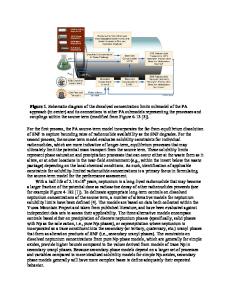A Quantitative Risk Assessment Perspective on the Source Term for the Proposed Nuclear Waste Repository at Yucca Mountai
- PDF / 380,559 Bytes
- 7 Pages / 595 x 841 pts Page_size
- 28 Downloads / 293 Views
A Quantitative Risk Assessment Perspective on the Source Term for the Proposed Nuclear Waste Repository at Yucca Mountain William M. Murphy1,2, B. John Garrick1, Bruce E. Kirstein1 1 U.S. Nuclear Waste Technical Review Board, Arlington, VA 22201, USA 2 Geological and Environmental Sciences, California State University, Chico, CA 95929, USA ABSTRACT A quantitative risk assessment methodology is outlined for the source term for the proposed geologic repository for high-level nuclear waste at Yucca Mountain, Nevada. The methodology involves construction of a logical event tree to identify scenarios for the success or failure of the waste isolation system. Uncertainties in the intervening events between initial conditions and consequences can be quantified using probability distributions for steps along each scenario path. Likelihood is quantified according to the frequencies for each split fraction in the event tree. The result is a calculated probability of frequency curve for the release rate(s) of the modeled radionuclide(s). INTRODUCTION Probabilistic performance assessment models are a tool for integrating the many technical features, events, and processes associated with isolation and release of nuclear wastes in a geologic repository and for calculating the possible environmental and human radioactivity exposures and effects. Performance assessments conducted by the U.S. Department of Energy [1] for the post-closure period of the proposed high-level nuclear waste repository at Yucca Mountain, Nevada, USA combine an approach of screening features, events and processes with a probabilistic radionuclide transport model. Uncertainties are comprehended by estimating ranges for uncertain parameters used in quantitative relations that describe the transport process. Numerous simulations are then performed using parameter values that are randomly sampled from prescribed distributions. Then transport models are generated and distribution functions are calculated for performance measures such as radionuclide release or annual dose. In contrast, quantitative risk assessment (QRA) (e.g., [2]) generally depicts a structured set of scenarios in an event tree that links initial conditions and final states or consequences. Uncertainties in the intervening events between initial conditions and consequences are quantified using probability distributions for steps along each scenario path. Risk is defined as a product of the risk triplet: i) the complete set of scenarios (things that can go wrong); ii) the likelihood of each scenario; and iii) the consequences of scenarios. Likelihood is defined quantitatively as the probability of the frequency of the given scenario [2,3]. A unique application of this approach to geologic disposal of nuclear wastes was completed recently for the West Valley, New York low level waste repository [4]. An event tree approach to post-closure performance assessment for the Yucca Mountain repository was used previously by the Electric Power Research Institute (e.g., [5]). A logic tree approach analogous
Data Loading...











